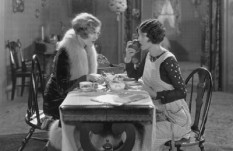The MoMI programme ran on two weekends from 17-25 March and presented a wide-ranging film series including lectures, personal appearances, and screenings of features, documentaries, silent films, video art, and newsreels, including Pat Kirkham’s lecture on Hitchcock’s Rear Window (1954) and Drake Stutesman’s lecture on Howard Hawks’s Fig Leaves (1926).
The theme of this dynamic programme was the deeply ambiguous relationship between film and fashion. The Festival investigateed how the moving image represents and interprets fashion as a concept, industry, and cultural form. Some of the films included in this series were William Klein’s Who are You, Polly Maggoo?, Slava Tsukerman’s Liquid Sky, Jennie Livingston’s Paris is Burning, Bruce Weber’s Chop Suey, Howard Hawks’s Fig Leaves and David Byrne’s directorial debut True Stories.
Between Stigma and Enigma was curated by Marketa Uhlirova and Christel Tsilibaris, with guest curators Roger K. Burton (festival co-founder), Alistair O’Neill, Adrian Garvey and Edward Barber. The programme was organized for the Museum by Chief Curator David Schwartz and Assistant Curator Livia Bloom.
Museum of the Moving Image
www.movingimage.us
Gallery








Themes and Events

Fig Leaves
Restored 35mm print from the Museum of Modern Art. Directed by Howard Hawks. This joyful satire suggests that fashion is the Satan responsible for the fall of (wo)mankind. Temptation is found in a decadent couture salon on “rue de la Fifth Avenue,” and the climax is a parade of Adrian’s designs.
More information »
True Stories
Directed by David Byrne. With John Goodman, Spalding Gray. In his first feature film, David Byrne used actual stories from supermarket tabloids to create an exaggerated patchwork exposé of American life. The stylized costumes play a key role in expressing Byrne’s incisive, cartoon-like vision.
More information »
Unzipped
Directed by Douglas Keeve. Photographed by Ellen Kuras. “Think Eskimos!” screams the outrageous, extroverted fashion designer Isaac Mizrahi, looking for inspiration to revive his career after several bad seasons. The film shows how Mizrahi achieves creativity amidst the frenzy of supermodels, celebrity friends, enemies, and magazine editors, and stages a fashion show that saves his sanity and his career.
More information »
Chop Suey
Directed by Bruce Weber. Part self-portrait, part documentary, photographer/filmmaker Bruce Weber’s startling and unpredictable film about fashion and photography centers on the discovery of a young male model and includes a portrait of iconic fashion editor Diana Vreeland.
More information »
Who Are You, Polly Maggoo? and Ceiling
These films are powerful commentaries on 1960s fashion and cinematography; Ceiling (1962, 42 mins. Imported 35mm print . Vera Chytilová) is an introspective essay, while Who Are You, Polly Maggoo? (1966, 102 mins., 35mm. William Klein) is an uncompromising parody. Like Antonioni’s Blow-Up, they take a critical approach to the worlds of fashion and media. Both Chytilová (a model in the early 1950s) and Klein (an on-and-off fashion photographer) were fashion-industry insiders, and thus ideally equipped to launch into a thorough investigation of the subject.
More information »
Lady with a Hat
Directed by Elsa Kvamme. This portrait film takes a staggering journey through the life and career of the Jewish hat-maker May Aubert, who used her millinery skills during World War II to smuggle money from Norway into Canada.
More information »
“Assuming a Pose”
Posing, dressing up, staging, and masking are at the heart of this program, which plays on cinema’s preoccupation with moments where reality meets fiction. “Posing” connotes not just a position or posture of the body, but also artificiality and pretense.
More information »
Model
Directed by Frederick Wiseman. Cinema verite pioneer Frederick Wiseman applies his cool, understated approach to examining the intersections of fashion, business, advertising, photography, television, and fantasy in the day-to-day lives of models at a New York agency.
More information »
Paris Is Burning
Directed by Jennie Livingston. A surprise hit when it opened in New York, this documentary reveals the downtown community of black and Latino drag queens who invented “voguing” and competed in lavish drag balls that both embraced and spoofed the world of high fashion
More information »
“Shoes, Eroticism, and Fetish”
Women’s shoes trigger amorous behavior and sexual fixations that can cause a breakdown in social etiquette. These films explore various routines of wearing and showing off shoes for the camera, focusing on notions of exhibition, voyeurism, and lust. In the Buñuel film, Jeanne Moreau is a maid at a country estate whose eccentric inhabitants include a boot fetishist.
More information »
Liquid Sky
Directed by Slava Tsukerman. In this time-capsule cult favorite, with plenty of early-1980s fashion, a pleasure-seeking alien lands in downtown New York and gets caught up in a world of casual sex and heroin abuse with androgynous hipsters Margaret and Larry (both played by Anne Carlisle).
More information »
Rear Window
Directed by Alfred Hitchcock. With James Stewart, Grace Kelly. Lisa Fremont, Grace Kelly’s fascinating and high-powered character in Hitchcock’s classic study of voyeurism, murder, and the fear of marriage, is based on the pioneering fashion consultant Anita Colby. Bard College professor Pat Kirkham writes widely about design, fashion, and film.
More information »
“The Enigma of Clothing”
This program celebrates the secret life of clothes and the enigmatic qualities that emanate from the filmic treatment of their materiality. Clothes and cloth, when filmed independent of the body parts that normally give them meaning, are revealed as estranged, dreamlike, playful, and elusive—making them potent carriers of fascination, desire, emotion, and sensual pleasure. Musical score by Karaoke Tundra/Muteme.cz.
More information »